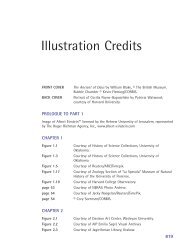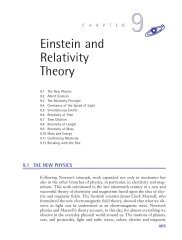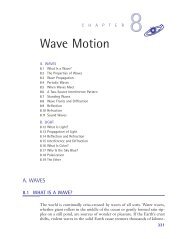Chapter 12: Electromagnetic Waves (545 KB) - D Cassidy Books
Chapter 12: Electromagnetic Waves (545 KB) - D Cassidy Books
Chapter 12: Electromagnetic Waves (545 KB) - D Cassidy Books
Create successful ePaper yourself
Turn your PDF publications into a flip-book with our unique Google optimized e-Paper software.
3637_<strong>Cassidy</strong>TX_<strong>12</strong> 6/13/02 11:34 AM Page 580580 <strong>12</strong>. ELECTROMAGNETIC WAVESAnother difficulty with belief in the ether was that all attempts to detectthe motion of the Earth relative to the ether failed (see <strong>Chapter</strong> 9). If lightis a kind of vibration of an ether that fills all space, then light should travelat a definite speed relative to the ether. But the Earth must also be movingthrough the ether in its annual orbit around the Sun. Thus, the Earthshould be moving like a ship, against an “ether wind” at some times, andwith it at other times. Under these conditions, the apparent speed of lightshould be observed to differ. When the Earth and a beam of light are movingin the same direction through the ether, the observed speed of lightshould not be the same as when the Earth and the light are moving in oppositedirections.Theorists computed the time required for a pulse of light to make around trip in a laboratory with and against the ether wind. They comparedthis interval with the time calculated for a round trip in the absence of anether wind. The expected time difference was found to be very small; only10 15 s for a round trip of 30 m. This is too short a time difference to measuredirectly, but it is of the same order as the time for one vibration ofvisible light. Therefore, the difference might be detected from observationsof a properly produced interference pattern. In 1887, the American scientistsAlbert A. Michelson and Edward Morley used a device sensitive enoughto detect an effect only 1% as great as that predicted by the ether theory.Neither this experiment nor the many similar experiments done since thenhave revealed the existence or expected effects of an ether wind.Supporters of the ether concept offered various explanations for this unexpectedresult. For example, they suggested that objects moving at highspeeds relative to the ether might change their size in just such a way as tomake this relative speed undetectable. But even those who made such attemptsto rescue the ether concept felt their proposals to be “ad hoc,”forced, and artificial. Finally, a decisive development led scientists to abandonthe ether concept. This breakthrough was not a specific experiment,but a brilliant proposal by a 26-year-old man.The man was Albert Einstein, who, as discussed in <strong>Chapter</strong> 9, suggestedthat a new and deep union of mechanics and electromagnetism could beachieved without the ether model, on the basis of the two fundamental postulatesof relativity theory: the relativity principle and the constancy of thespeed of light. The price of accepting these postulates was, Einstein showed,the necessity of revising some common-sense notions of space and time.Einstein showed that Maxwell’s equations are fully consistent with extendingthe principle of relativity to all physics. This was yet another great synthesisof previously separate ideas, like the syntheses forged by Copernicus,Newton, and Maxwell.






